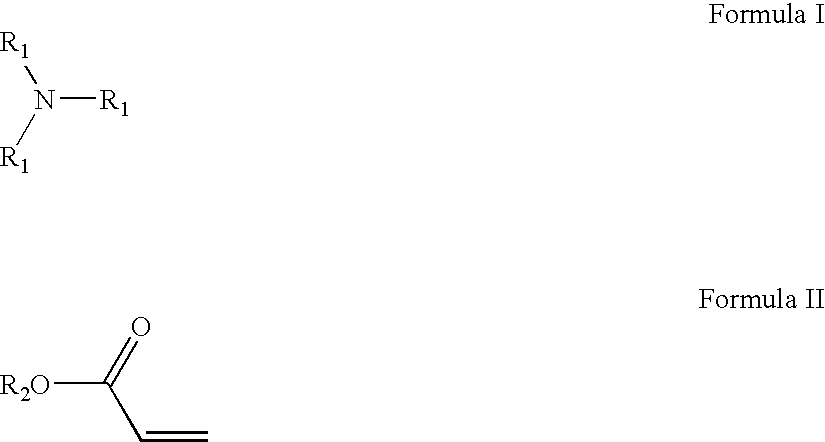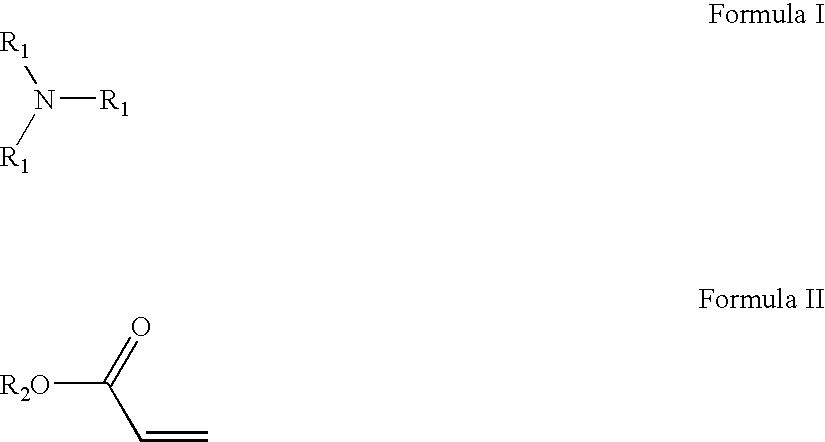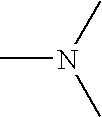Amido-amine polymer compositions
a technology of amines and polymers, applied in the field of amine polymer compositions, can solve the problems of reducing the binding effect of phosphate, affecting the phosphate binding effect,
- Summary
- Abstract
- Description
- Claims
- Application Information
AI Technical Summary
Benefits of technology
Problems solved by technology
Method used
Image
Examples
example 1
Synthesis of Compound I
[0244]2.5 g of a chilled solution (2° C.) of tris(3-aminopropyl)amine in 2.5 ml of anhydrous methanol was added to an ice water bath chilled solution (2° C.) of 8.7 ml of methyl acrylate in 10 ml of anhydrous methanol. The solution was allowed to slowly warm to room temperature and was stirred six days at room temperature. The solution was concentrated on a rotary evaporator (bath temperature at 40° C.) yielding a light-yellow colored viscous oil. 50 ml of anhydrous methanol was added to this material and the solution was concentrated on a rotary evaporator (bath temperature 40° C.). The addition of anhydrous methanol (40 ml) and concentration on a rotary evaporator was repeated two additional times. The resulting material was dried in vacuo yielding 9.15 g of viscous oil.
example 2
Synthesis of Compound II
[0245]10 g of a chilled solution (2° C.) of tris(2-aminoethyl)amine in 10 ml of anhydrous methanol was slowly added to an ice water bath chilled solution (0° C.) of 45 ml of methyl acrylate in 40 ml of anhydrous methanol. The solution was allowed to slowly warm to room temperature and stirred for six days at room temperature. The solution was concentrated on a rotary evaporator (bath temperature 40° C.) to yield a light yellow viscous oil. 50 ml of anhydrous methanol was added to this material and the solution was concentrated on a rotary evaporator (bath temperature 40° C.). The addition of anhydrous methanol (40 ml) and concentration on a rotary evaporator was repeated two additional times. The resulting material was dried in vacuo.
example 3
Synthesis of Compound III
[0246]10 g of a chilled solution (2° C.) of DAB-4 in 10 ml of anhydrous methanol was slowly added to an ice water bath chilled solution (0° C.) of 28 ml of methyl acrylate in 28 ml of anhydrous methanol. The solution was allowed to slowly warm to room temperature and stirred for five days at room temperature. The solution was concentrated on a rotary evaporator (bath temperature 40° C.) to afford a light yellow colored viscous oil. 50 ml of anhydrous methanol was added to this material and the solution was concentrated on a rotary evaporator (bath temperature 40° C.). The addition of anhydrous methanol (40 ml) and concentration on a rotary evaporator was repeated two additional times. The resulting material was dried in vacuo to afford 30.11 g of the desired product.
PUM
| Property | Measurement | Unit |
|---|---|---|
| polydispersity | aaaaa | aaaaa |
| height | aaaaa | aaaaa |
| height | aaaaa | aaaaa |
Abstract
Description
Claims
Application Information
 Login to View More
Login to View More - R&D
- Intellectual Property
- Life Sciences
- Materials
- Tech Scout
- Unparalleled Data Quality
- Higher Quality Content
- 60% Fewer Hallucinations
Browse by: Latest US Patents, China's latest patents, Technical Efficacy Thesaurus, Application Domain, Technology Topic, Popular Technical Reports.
© 2025 PatSnap. All rights reserved.Legal|Privacy policy|Modern Slavery Act Transparency Statement|Sitemap|About US| Contact US: help@patsnap.com



